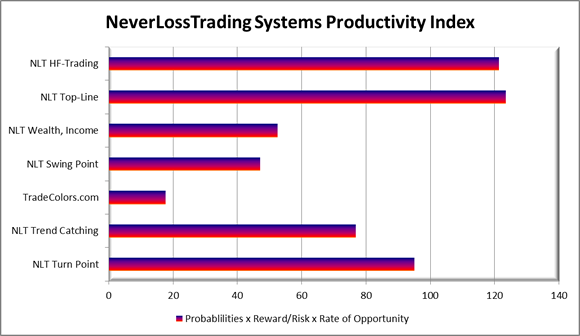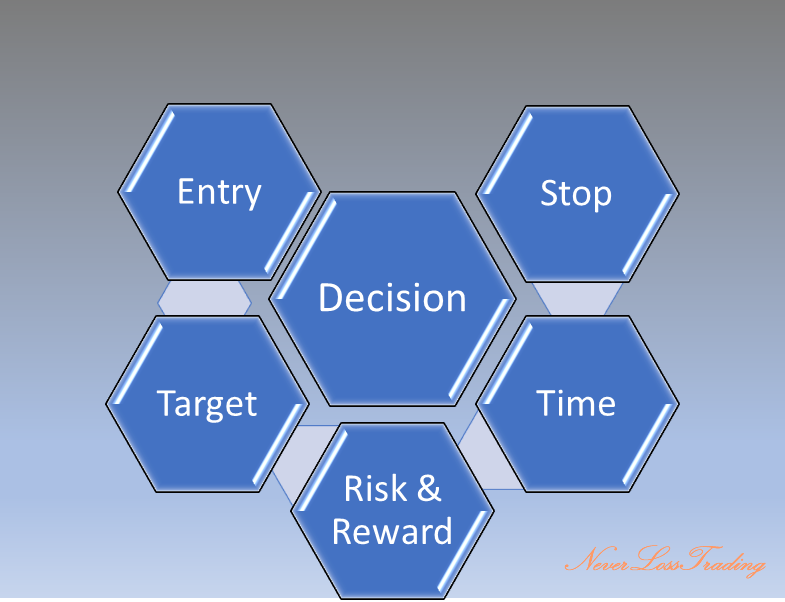Summary: Stocks experience strong price moves when publicly-traded companies deliver their quarterly earnings reports. We share a systematic approach, how you can spot and participate in those opportunities as a retail trader.
Read on, watch the video or listen to our PodCast.

- Introduction
At NeverLossTrading, we start to look about 20-trading-days (four weeks) in advance to the earnings call for price move indications and act on them. Here is an example for NVDA:
NVDA, NLT Weekly Top-Line Chart, Sept. – Nov. 2021

The chart indicated Buy > $257.09, and we only act if this price threshold is surpassed in the price movement of the next candle, which was the fact. The system also indicated an expected price move of 2-SPU, reaching $295.50 (achieved). After that, the stock price went even higher and then fell back to the stated level.
Typically, we do not want to open or hold speculative positions two days before earnings and the day after.
The reason for this:
- High volatility and an unreasonable risk that stops getting triggered.
- Market-plays by big money flooding or shortening supply and triggering strategic price moves, which bare an unbalanced risk for the trader or investor
What to do if you hold a long-term position?
You work with a form of protection by adding options to the stock for not carrying a risk outside a set risk tolerance: no more than 5% risk per position.
SBUX, NLT Top-Line October/November 2021

The chart shows, we had two NLT Top-Line signals indicating buy opportunities when the price threshold was surpassed in the price movement of the next candle: This was the fact, and the system displayed a price target of $115, with entry at $110.15, a 4.4% return on cash when buying the stock and multifold when trading with an options strategy. This NLT signal also indicated that the target price should be reached in a maximum of five days, which was the fact.
As a trader or investor, always consider: you are making an assumption about the future outcome of a trade, but you are only in control of the risk by applying risk-limiting strategies.
All of this is learnable, and we are here to help in a one-on-one session, transferring the appropriate indications, strategies and risk-liming actions: Skills, rarely to be found but learnable.
If you want to see how our systems work life, schedule a consulting hour: contact@NeverLossTrading.com Subj: Demo.
2. Content of Earnings Reports
Earnings reports contain a variety of financial information on the corporate quarterly business’s performance, including:
- Balance Sheet
- Income Statement
- Cash Flow Statement
- Market and Sector Performance
When a quarter ends, public companies start to report their actuals and business outlook. Companies with a significant impact on their actuals and outlook are what the market spots for.
NeverLossTrading Top-Line includes what we call the NLT Seasonal Projection Study, which indicates if stocks have a usual pattern of usually dropping into earnings and potentially coming out strong. Sure, history does not need to repeat itself, but when institutional investors consider a particular pattern, you better be aware of it.
Here is an example of IBM, which had a pattern of weakness into and out of October earnings:
IBM, NLT Seasonal Projection, September – December 2021

The red arrows on the chart identify expected price drops of ≥ 5% in a matter of 10 days. In the actual situation, IBM dropped close to 17% and offered an excellent opportunity to participate in its seasonal pattern for those who knew it.
Does a stock always follow this pattern?
No, but we found a high likelihood in it, and such it adds to other of our indications, helping traders spot substantial price move opportunities.
3. Start of the Earnings Season
We are just concluding an earnings season; as a rule of thumb, the reports of critical financial institutions, about two weeks after the end of the quarter starts the season: JP Morgan (JPM), Morgan Stanley (MS), Goldman Sachs (GS), Bank of America (BAC). Aside from declaring their actual quarterly achievements, those companies forecast other company’s performance based on in-depth research and give expectation value for:
- Earnings per share
- Sales
- Profit margins
- Unit sales
These forecasts are considered in estimates by financial news organizations like Reuters and Bloomberg. At times, the numbers differ slightly, but they are generally very close.
The hype of earnings declarations comes about four weeks into the earnings season, when AAPL and AMZN report and give a core outlook for the sector. At the peak, over 150 companies report earnings in a single day, offering you plenty of opportunities to participate in trades in and out of earnings with a solid system indication on hand.
4. Price Move Indications
In the NeverLossTrading Alerts, we highlight the days to the earnings announcement on all listed stocks, so you know if you trade with an additional risk or opportunity. But you also find indications for the earnings release on our charts to see the day, time, and expectations of the earnings release, and we teach the details in our mentorships.
You can also find a company’s earnings date on a variety of websites. We generally recommend Yahoo Finance.
NLT Stock Alert Example for November 5, 2021

The NLT Alert reports on multiple levels are helping you to put those opportunities in action with conditional buy-stop or sell-stop orders. For example, the alert for November 5 showed two short trades: NFLX and BK. In the price continuation of the next day, only NFLX surpassed its price threshold and led to a trade.
NFLX with NLT Top-Line Signal for November 5, 2021

The impact of earnings on a stock price is not an exact science. Here is a small selection of the factors that can impact a stock’s reaction to earnings:
- Earnings per share (relative to expectations)
- Sales (relative to expectations)
- Profit margins (relative to expectations)
- Product unit sales (relative to expectations)
- The company’s future outlook (relative to expectations)
- Comments made by executives on the conference call
- How much the stock is up or down before earnings
“Prediction is challenging, especially if it’s about the future;” hence, it is not uncommon for a company to beat expectations and share prices fall or report terrible earnings, and we see its stock rise.
Why does that happen?
It’s all about expectations, the appraisal, and the action of institutional money: This is why our indicators spot and follow institutional money flow to indicate with a high probability where the price move is most likely going to start and end.
Hence, we let the market and institutions appraise the stocks price journey and latch on, entering and exiting positions faster than institutions can. Here is the price move model we follow:
5. NeverLossTrading Price Move Model

Theory: Key asset holders will have a solid need to re-balance their inventories. Thus, at a particular price expansion, they will either float- or shorten supply, which will result in an opposite directional price move that will then take away from our profits. Knowing this, we pre-calculate how far the expected price move will reach, and there we take profit, assuming it will retrace or reverse after.
Our brand name derives from the concept of repairing a trade instead of accepting a stop loss; however, Never Stop Loss Trading was a bit lengthy.
TradeColors.com is our introductory system to high probability trading. We always allow for upgrades; you only pay the difference if you start with TradeColors.com and upgrade after.
Many of our clients buy more than one system: Our systems are productivity tools, and by combining them, you produce a higher participation rate and higher returns.

6. Exit Strategy
Our tool to calculate the expected price move is the SPU = Speed Unit, and it indicates how far a price move shall reach until it comes to an end.
With our systems, you can operate with conditional buy-stop and sell-stop OCO orders (one-cancels-the-other). Without the need to be in front of your computer for the orders to execute. You are entering by price thresholds, ensuring that other market participants have the same directional assumption as you do and exit at the SPU target or adjust the trade at the stop.

By a change in the frequency and amplitude of the price movement over time, we specify indications to act on high probability price turning points, applying mechanical rules rather than leaving room for interpretation.
7. Earnings Strategies
Instead of buying the stock, a risk-limiting strategy traders apply is buying Call or Put options ahead of earnings reports in the hopes of catching a big move up or down.
However, there is a problem with this approach.
Options are costly ahead of earnings, which makes it difficult to get a good return on them.
When we scroll back to the NLT Alert, you see that we list fair prices for options, so you are always aware of options being reasonable priced or overpriced.
NLT Alert for November 5, 2021

The last columns show what a fair option price is, and such you are always in the position to decide if Put or Call options are a good investment instrument.
Vega, a measure of the implied volatility, needs to be considered, which is usually extremely high ahead of earnings and collapses after. In our mentorship, we share alternative ways to work around this issue and still limit your risk of a trade in- and out of earnings.
There is always a way to participate in a trade, and it is learnable.
The current earnings season is ticking off the calendar, but the next one is coming up in January 2022 and if you want to be ready, contact us for a demo and consulting hour:
contact@NeverLossTrading.com Subj. Demo
Earnings trades are only one of the strategies we teach, and we are happy to get together with you and find out which of our systems best suits your wants and needs, helping you to solve five major dimensions of trading, where many mistakes can be made:
- Trade entry decisions
- Exit decisions
- Stops (where to place them)
- Maximum time in a trade
- Risk to reward

In addition: we are offering a year-end special you do not want to miss out on.
We are happy to hear back from you.
Thomas Barmann (inventor and founder of NeverLossTrading)
Disclaimer, Terms and Conditions, Privacy | Customer Support


No comments:
Post a Comment